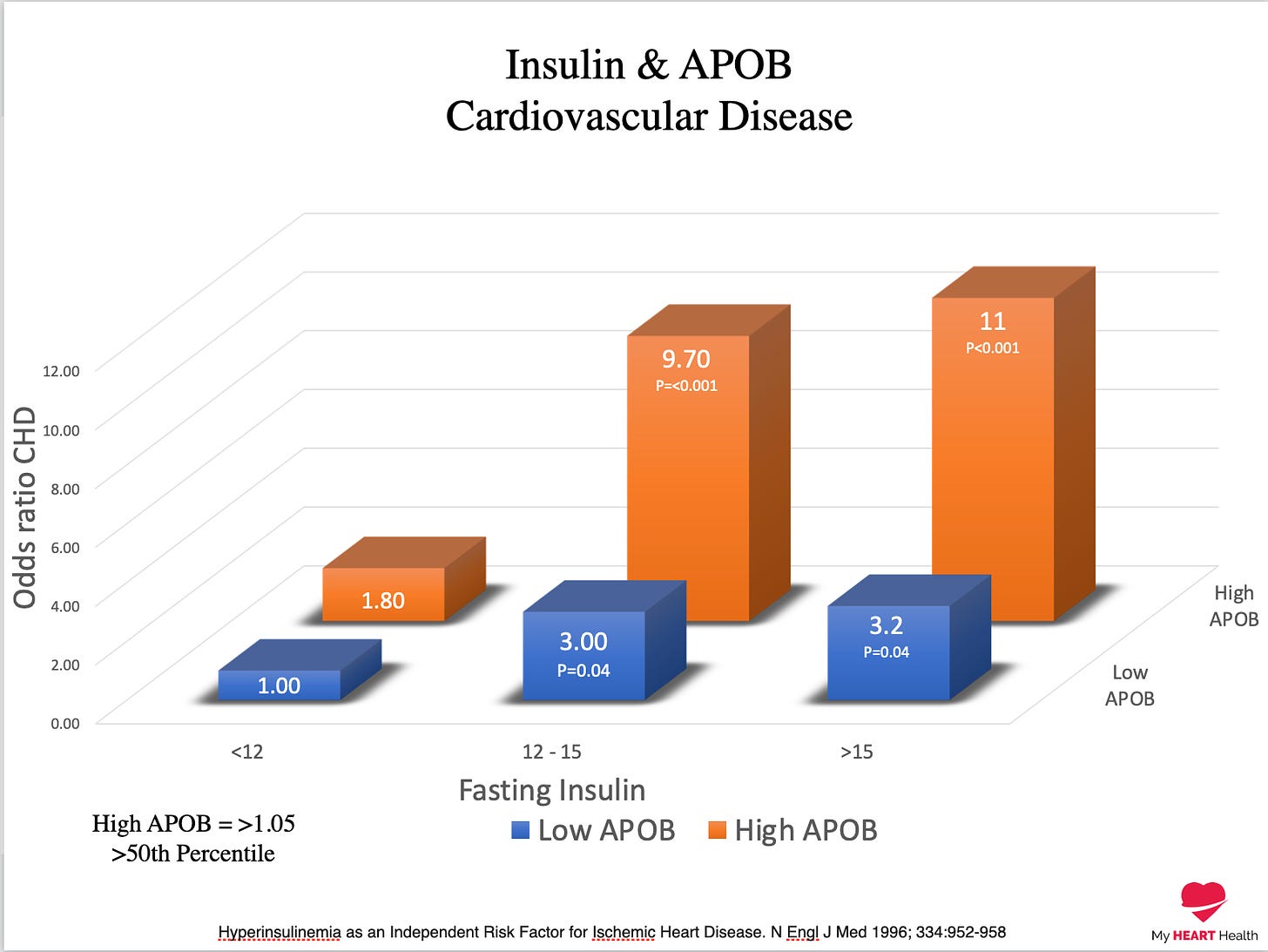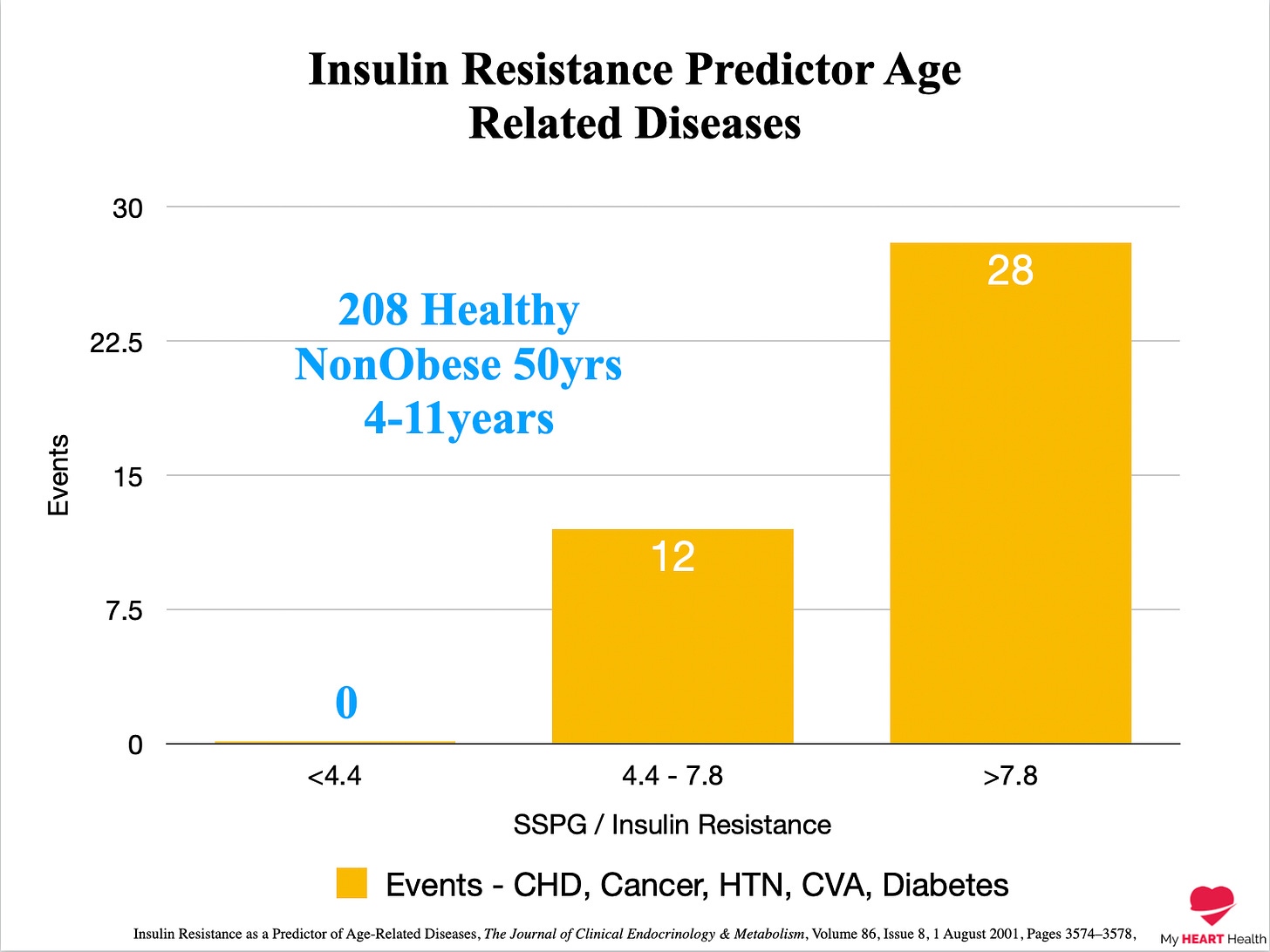How To Test For Insulin Resistance

Insulin resistance is a core risk factor for the three leading causes of death:
-
Cardiovascular Disease
-
Cancer
-
Dementia.
Insulin resistance is unlikely to be the primary causal factor for these conditions but is likely to be a major accelerant.
Take cardiovascular disease, for example.
With no insulin resistance and high APOB (LDL-C), the risk of future heart events increases by about 80%.
However, if you add insulin resistance into the mix, that risk goes up by 11 FOLD1.
Again, think pouring gasoline on a fire.

But this force multiplication of risk exists for many other major medical conditions that are likely to be the cause of early death also.
We know that those with insulin resistance have higher rates of:
-
Nonalcoholic Fatty Liver Disease (NAFLD)
-
Atrial Fibrillation
-
Heart Failure
-
Sleep Apnea
When you examine ‘healthy’, middle-aged normal-weight individuals and follow them for about a decade, the ones who did not have insulin resistance at the outset rarely get cancer, diabetes, high blood pressure or a stroke.
The ones who do have insulin resistance, however, have much higher rates of all these conditions over the following decade2.

So we know that having insulin resistance increases the risk of most of the major medical conditions we are typically concerned about but…..
How do you know if you are insulin resistant?
There are many ways you can test for insulin resistance.
Some are very simple, although not very precise.
Some are very precise but more complex.
So let’s go from the most simple to the most complex.
Waist Circumference.
All you need is a tape measure.
This is a measure around your abdomen at the level of your belly button.
This is not your jean size.
A waist circumference of:
-
For Males: >102cm/40 inches
-
For Females: >88cm/35 inches
Is highly suggestive of insulin resistance3

The issue with using waist circumference to identify insulin resistance is that it likely only flags it as an issue when things have progressed very far.
So it’s likely to be predictive, but only at a very late stage.
Let's see if we can spot things a little earlier.
Metabolic Syndrome
Metabolic syndrome is a collection of 5 features.
Having 3 of any of the following 5 features means that you meet the criteria for metabolic syndrome.
-
Elevated blood pressure > 130mmHg (Systolic)
-
Abnormal fasting glucose
-
High Triglycerides - > 1.7 mmol/l (150 mg/dl)
-
Low HDL Cholesterol - (Males: <1.0 mmol/l (39 mg/dl), Females < 1.3 mmol/l (50 mg/dl)
-
Enlarged waist circumference (As above)
Metabolic syndrome is the phenotypic manifestation of insulin resistance.
Even having one of these 5 features is suggestive of insulin resistance.
It is estimated that 88% of the adult US population has at least one of these factors4.
For each additional feature, the likelihood and likely severity of insulin resistance increases.
Just for clarity, type 2 diabetes is when insulin resistance progresses to the point that your body can no longer keep your blood glucose levels under control.
So if you have type 2 diabetes, you, by definition, are insulin resistant.
However, just because your glucose levels are normal does not mean you do not have insulin resistance. Insulin resistance can be present for years before blood glucose levels become abnormal.
Although type 1 diabetes is not characterised by insulin resistance, it is increasingly recognised in this population also.
TyG Index
The TyG index is a way of estimating the likelihood of insulin resistance by measuring your serum glucose and triglycerides.
Both of these are usually measured on standard blood tests.
The equation used to calculate the TyG Index is:
ln [Fasting triglyceride (mg / dl) x Fasting glucose (mg / dl)] / 2
You can access a calculator to estimate your score here.
A score of > 4.5 means there is more than an 80% chance that you have some degree of insulin resistance.
The key thing to remember with this formula is that both test results will need to be input in mg/dl units. This can be easily converted from mmol/l with any free converter online.
HOMA-IR
HOMA-IR stands for the Homeostatic Model Assessment for Insulin Resistance.
It is a measure of insulin resistance using fasting serum insulin and glucose.
Assessing fasting glucose is very straightforward.
Assessing fasting insulin can be tricky and often needs to be done in a major hospital lab setting. Testing fasting serum insulin with your GP or primary care doctor can be a challenge for two reasons.
-
The sample usually has to be put on ice and processed in the lab very shortly after it has been drawn. For some practices, it may not be possible to guarantee this will happen.
-
Many doctors are just unaware of this test and often say that it is “only done for research purposes”. This is not true.
With the results of your fasting serum insulin and glucose, a HOMA-IR score can be calculated.
You can find a free HOMA-IR calculator here.
It is very important to note that very careful attention must be paid to the units on the test result and what is needed for any of the online calculators.
If you enter either one of these in the wrong units, you will get a completely inaccurate score.
A HOMA-IR score > 2.5 is highly suggestive of insulin resistance.
A HOMA-IR score of >3 is very suggestive of insulin resistance.
Matsuda Index
Similar to the HOMA-IR score, the Matsuda Index estimates the likelihood of insulin resistance in the fasted state but also examines how insulin and glucose levels change in response to a glucose drink.
Samples can be obtained at multiple time points after the ingestion of the glucose drink and entered into a calculator.
While some people show no evidence of insulin resistance in the fasted state and have a normal HOMA-IR, they can show evidence of insulin resistance after ingestion of a glucose load.
This post-prandial signal often appears first and is missed on HOMA-IR testing alone in the fasted state.
Once again, very careful attention should be paid to the units of any results entered into any online calculators.
An example of a Matsuda Index calculator is available here.
If you are not very comfortable with converting units etc., tread with caution here.
Euglycemic Clamp Study
This is the gold standard for assessing insulin resistance.
A full description is beyond the scope of this article, but it involves the continuous infusion of varying amounts of intravenous glucose and insulin and repeated blood draws.
This is typically only done in research settings. (**It’s this one. Not the HOMA-IR).
This is the test that all the other tests are often validated against.
It is also the only one that, if done incorrectly, can be fatal.
So let’s just stay clear of this one for now.
Main Takeaway
Insulin resistance is a core risk factor for all the major chronic diseases that impact us.
Most importantly, insulin resistance is highly reversible with the right combination of good sleep, exercise and nutrition.
The problem is that most people who have insulin resistance don’t know they do.
And even for those who do have a degree of insulin resistance, using the tests listed here are useful ways to track progress over time to the healthy insulin-sensitive state.
Just as you would get your cholesterol or your blood pressure checked as part of a health evaluation, an assessment of insulin resistance should also be included.
There are many complex ways to evaluate insulin resistance, and I would advise that, if at all possible, you do a HOMA-IR score at a minimum.
However, if for some reason that is not possible, there are other easily available tests that can be done and tracked over time.
Insulin resistance is a powerful hidden epidemic.
Let’s put it in plain sight and get to work reversing it.
Hyperinsulinemia as an independent risk factor for ischemic heart disease. N Engl J Med. 1996 Apr 11;334(15):952-7.
Facchini FS, Hua N, Abbasi F, Reaven GM. Insulin resistance as a predictor of age-related diseases. J Clin Endocrinol Metab. 2001 Aug;86(8):3574-8. doi: 10.1210/jcem.86.8.7763. PMID: 11502781.
Tabata S, Yoshimitsu S, Hamachi T, Abe H, Ohnaka K, Kono S. Waist circumference and insulin resistance: a cross-sectional study of Japanese men. BMC Endocr Disord. 2009 Jan 12;9:1. doi: 10.1186/1472-6823-9-1. PMID: 19138424; PMCID: PMC2635363.
Araújo J, Cai J, Stevens J. Prevalence of Optimal Metabolic Health in American Adults: National Health and Nutrition Examination Survey 2009-2016. Metab Syndr Relat Disord. 2019 Feb;17(1):46-52. doi: 10.1089/met.2018.0105. Epub 2018 Nov 27. PMID: 30484738.




